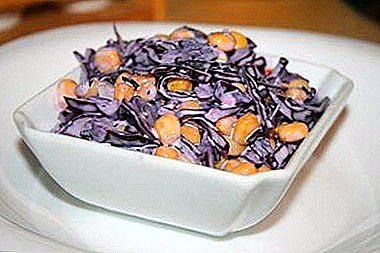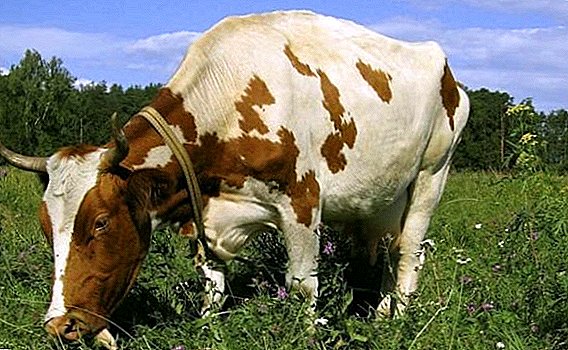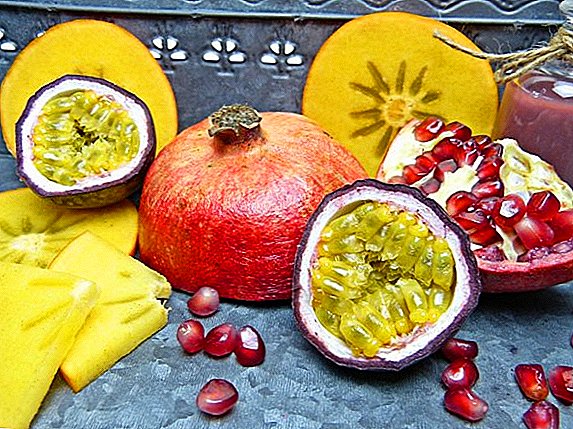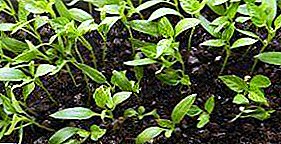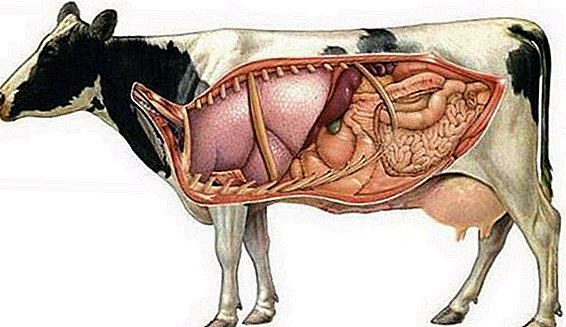 A cow is a ruminant that feeds primarily on roughage. It has a multi-chamber stomach, adapted for the digestion of large volumes of plant food. Different departments of this body carry out mechanical and enzymatic processing of feed, increase its assimilation. This article will discuss the device of a cow stomach and how to start it after stopping.
A cow is a ruminant that feeds primarily on roughage. It has a multi-chamber stomach, adapted for the digestion of large volumes of plant food. Different departments of this body carry out mechanical and enzymatic processing of feed, increase its assimilation. This article will discuss the device of a cow stomach and how to start it after stopping.
How does the stomach of a cow
Food moves along the cow's stomach progressively, passing from the rumen through the mesh into a book, and then into the abomasum. The net is designed for filtering liquid ground feed. Each department has its own peculiarities of the processes occurring in it, however, the stomach is a single system.
Important! The calf's stomach is not adapted to digesting roughage, so the groove that divides the scar into two bags has a tube shape. Through this tube, the milk flows from the esophagus immediately into the abomasum, bypassing the foreglobe. Solid feeds as complementary foods should be introduced to calves in the diet not earlier than one month of age, since the rennet cannot digest them without prior treatment in the foregut.
Which side
The stomach is a voluminous organ that occupies the entire central part of the abdominal cavity of the animal and is located at the level of 4-12 intercostal space. In the front part of the stomach is connected with the esophagus, and in the back connects with the duodenum.
How many departments and their functions
There are four divisions in this organ, but the scar and the mesh are practically not separated from each other and are collectively called the reticular stomach. 
Scar
This is the main department, the first and largest. Its volume in adults reaches two hundred liters. There is a scar in the left part of the abdominal cavity and occupies a small proportion of the right. The trough, in which calves dairy feed passes immediately into the abomasum, divides this section into two bags lined with a double layer of muscle tissue.
This department does not have glands, but it carries out mechanical grinding of feed, ensures its grinding and mixing. The volume of the scar is enormous - it takes up to 80% of the total volume of the stomach and is the most weighty internal organ.
Did you know? The average weight of a healthy two-year-old cow is 700 kilograms, a bull - a little more than a ton. It may seem surprising that the weight record belongs to the cow. A representative of the Holstein hybrid named Mount Katahdin in 1906 reached a weight of 2,200 kilograms. The girth of her chest behind the shoulder blades exceeded 4 meters, and the height at the withers reached 2.
The simplest bacteria that inhabit the rumen, process food. They ferment sugars, carry out the primary fermentation of green mass, form vitamins and proteins. Depending on the food that the animal receives, the intestinal microorganisms change to successfully digest food, therefore the microflora of the stomach is variable.
Video: evaluation of cow rumen The muscle walls of the rumen contract every second and, after primary processing, push the food ball back into the esophagus and mouth of the animal. The cow begins to chew gum, additionally grinding the already fermented mass with molars.
Grid
It is a heavy, but small sorting department - it takes up no more than 10 liters. Located in the front of the abdominal cavity in front of the main section and partially in contact with the diaphragm. It is the grid that triggers the process of chewing gum into the esophagus.
Important! Grazing of cattle in fields with legumes should be carried out exclusively in dry weather. Under conditions of excessive moisture, nodule bacteria inhabiting the stems of leguminous plants begin to actively produce nitrogen-containing gases. In the rumen, this process is accelerated, the animal gets timpani and, as a result, the stomach stops working.It filters out the liquid fraction using its cellular mucous membrane and passes it further along the digestive tract, and discards large solid particles back.

Book
This department accepts liquid partially digested food. He is responsible for the mechanical processing of food, the breakdown of fiber and the absorption of the predominant amount of liquid. The liquid is squeezed and drained to prevent the dilution of enzymes and acid in the fourth section, rennet.
Did you know? Just like people have fingerprints, the imprint of a cow's nose mirror is unique. This feature is used by Texas pastoralists, who maintain a database of livestock and, if necessary, search for and identify the stolen animals by their fingerprints.The book consists of thin muscle walls, similar to leaves, between which the food is processed with saliva and its fermentation under the influence of bacteria. The size of the book is small: in adults it hardly reaches the diameter of a volleyball ball.
Abomasum
 Appearance of the stomach sections of the cow. It represents the true stomach of the animal - rennet juice is secreted in its glands, which consists of hydrochloric acid and enzymes. Juice is responsible for the final digestion of food and complete decomposition of its protein part.
Appearance of the stomach sections of the cow. It represents the true stomach of the animal - rennet juice is secreted in its glands, which consists of hydrochloric acid and enzymes. Juice is responsible for the final digestion of food and complete decomposition of its protein part.
The abomasum is at the level of the twelfth intercostal space and in an adult animal reaches a volume of 15 liters. It has a complex folded structure, which significantly increases the area of glandular tissue and, accordingly, the amount of rennet juice.
The cow's stomach does not work (got up)
Stomach problems in cattle occur mainly due to the fault of the owner. If the feed is of poor quality or has not been processed properly, and the animal has consumed it, intestinal motility will slow down and then stop altogether. Symptoms of the risen stomach will be loss of appetite, cough, chewing in vain, difficulty breathing.
Read more about the anatomy of a cow, as well as get acquainted with the structural features of the eyes, teeth, udder and heart of this animal.
Why
- Large feed particles. Root crops, corn cobs and briquetted feed need to be processed. Whole pieces of food will not be able to grind the scar, and this will cause stomach to stop.
- Long fasting. If the animal has been without food for a long time, and then received it in unlimited quantities, it will greedily swallow it, not worrying about chewing. The muscular bag of the scar will not be able to cope with the grinding of large parts of the feed and a blockage plug of the groove connecting the scar with the mesh is formed.
- Foreign objects. Unlike horses, cows eat everything they give. They do not feel the feeder with their lips, but absorb the mass indiscriminately, which leads to the ingestion of stones, nails and other inedible objects into the esophagus. These objects can provoke not only the stop of digestion, but also intestinal perforation.
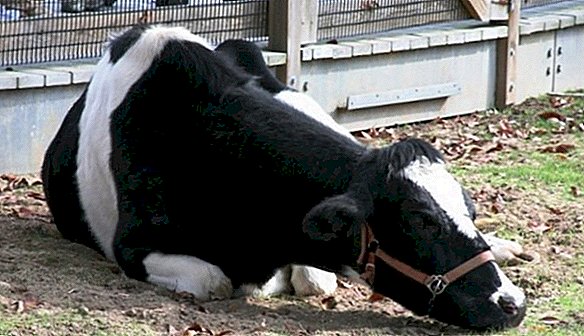
- Stomach spasm. The cause of spasm can be a sharp startle or severe stress. The muscle walls of the esophagus are narrowed, and peristalsis completely stops.
- Poor quality food. Rotten roughage, fermented and moldy green mass, overdue feed provoke an increase in microflora, an increase in the amount of intestinal gases and, as a result, timpani and stopping of the stomach.
Important! Foreign body that fell toandwith the feed, can injure the intestinal mucosa and exit naturally. Stopping the work of the stomach in this case occurs some time later and is triggered by paralysis of the esophagus at the site of damage or perforation of the wall.
What to do, how to run the stomach of a cow
Stopping digestion not only causes discomfort to the animal, but also leads to its imminent death. There are several ways to restart the stomach.
Traditional means
- Probe. Designed to destroy and push the cork further down the esophagus. For its introduction, the animal must be carefully tied on the shortest possible leash to a stable object. Then you need to cook 2-3 liters of vegetable oil, a liter for each centner of animal weight. The hand with which the oil will flow will need to be wrapped with a thick cloth to prevent damage.
 The animal's mouth should be opened wide and a wedge inserted between the jaws so that the cow cannot close them. Oil should be poured from the side of the jaw. As soon as the animal swallows a large part of it, it is necessary to introduce a large-caliber probe slowly and carefully, smoothly moving it down the esophagus. The oil will lubricate the esophagus and soften the cap, and the probe will destroy it, and intestinal peristalsis will gradually start itself.
The animal's mouth should be opened wide and a wedge inserted between the jaws so that the cow cannot close them. Oil should be poured from the side of the jaw. As soon as the animal swallows a large part of it, it is necessary to introduce a large-caliber probe slowly and carefully, smoothly moving it down the esophagus. The oil will lubricate the esophagus and soften the cap, and the probe will destroy it, and intestinal peristalsis will gradually start itself. - Manual extraction. Suitable for removing objects stuck in the larynx that can be seen through the skin. The cow must be fixed in the manner indicated above. The hand, which will be carried out the extraction, you will need to wear a thick glove and wrap the cloth from hand to shoulder. To remove an object, it is necessary to gently move the arm along the esophagus to the site of obstruction, hook the object and carefully pull it out through the mouth cavity.
Did you know? The amount of methaneallocated to the world livestock of cattle is colossal. In 2016, UN ecologists estimate that a third of all methane released into the atmosphere occurs as a by-product of the decomposition of manure. As for greenhouse gases, cows produce a fifth of the emissions, overtaking the volume of cars and airplanes together.
- Massage. This method is suitable for pushing an object stuck in the larynx area. It is necessary to pour 300 milliliters of vegetable oil into the larynx of the cow, clasp its neck with its hands and perform stroking strokes along the jugular trough from the larynx to the lower line of the jaws. Having enlisted the support of an assistant, you can pull out the tongue from the cow's mouth - this will become an effective stimulation of the gag reflex.
- Puncture. It is used in cases where the blockage has caused scar inflation. The scar is punctured by the trocar (a surgical instrument for penetrating the body cavity without breaking its tightness). This procedure is carried out mainly by a veterinarian.
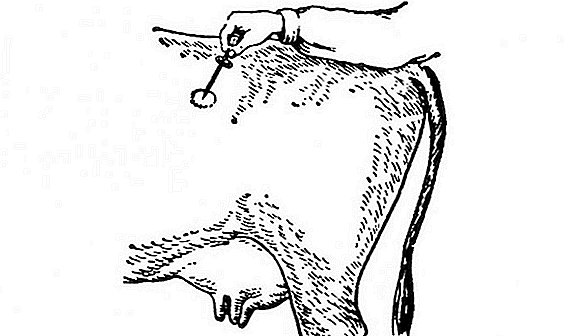
- Operation. It is best carried out exclusively in a veterinary clinic or on a specially equipped farm with foreign objects in the intestines of the animal. The operation is accompanied by intramuscular injection of antispasmodic substances. Independent surgical removal of foreign objects from the abdominal cavity is unacceptable.
You will probably be interested to read about why the cow needs horns.
Folk remedies
Feeding the animal various stimulating fluids includes:
- Yeast mixture. 200 grams of yeast diluted in half a liter of warm water. Once the yeast is swollen, they add 250 milliliters of vodka and 150 grams of fructose or sucrose. The resulting liquid is fed to the animal 2 times a day in half a liter for 3 days before the full resumption of the ruminant reflex.
- Hellebore. The tincture of this plant is mixed with water in a 1: 1 ratio and half an liter is fed to the animal twice a day.
- Garlic tincture. Half a liter of vodka is mixed with two heads of peeled and finely grated garlic. The resulting mixture is infused for one hour and the cow is drunk twice a day, 250 ml at a time.

Since, after pushing the cork through, the stomach starts up by itself, it is necessary to give it additional stimulation. In this case, the massage of the hungry fossa with the back of the hand or a tightly clenched fist, as well as the active exercise of the animal for 3-4 hours after the launch helps.
Important! ATAir pumped through a probe after drinking oil or a stimulating fluid will help to expand the walls of the esophagus or the stomach chamber and will make it easier to push the food mass. You can also pour 2-3 liters of warm water through the probe: it will put pressure on the walls of the stomach and thereby increase its permeability.
The blockage of the esophagus, which causes the stomach to stop, is complete and incomplete. With complete blockage, the animal must be cured in one day. In case of incomplete blockage in the intestine there is a small lumen through which fluids can pass, therefore it is acceptable to carry out treatment for 2-3 days.
The sooner the stomach starts up again, the lower the probability of the development of pathological processes and the appearance of complications in it. Feed your cattle only high-quality feed and check the food for the presence of foreign objects to prevent the stomach from stopping, and not to re-start it.



 The animal's mouth should be opened wide and a wedge inserted between the jaws so that the cow cannot close them. Oil should be poured from the side of the jaw. As soon as the animal swallows a large part of it, it is necessary to introduce a large-caliber probe slowly and carefully, smoothly moving it down the esophagus. The oil will lubricate the esophagus and soften the cap, and the probe will destroy it, and intestinal peristalsis will gradually start itself.
The animal's mouth should be opened wide and a wedge inserted between the jaws so that the cow cannot close them. Oil should be poured from the side of the jaw. As soon as the animal swallows a large part of it, it is necessary to introduce a large-caliber probe slowly and carefully, smoothly moving it down the esophagus. The oil will lubricate the esophagus and soften the cap, and the probe will destroy it, and intestinal peristalsis will gradually start itself.
